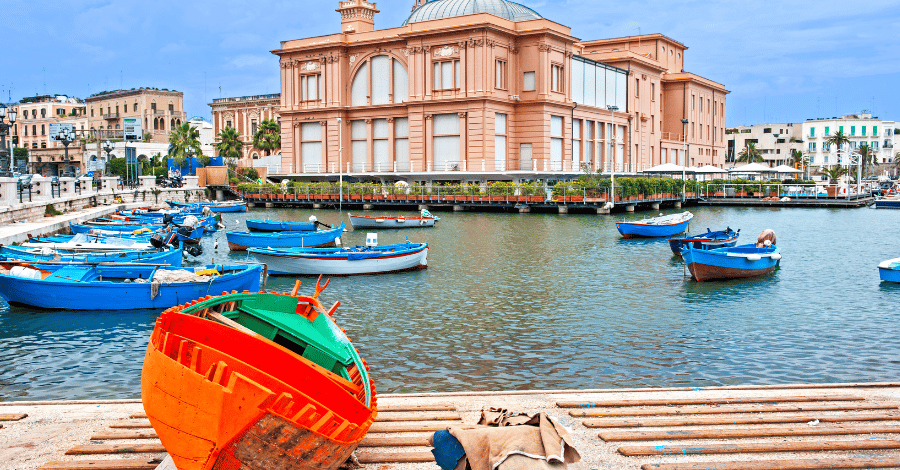Whatever the reason for your move to Italy, you’ll want to know where you can afford to live based on your budget. In this article, we’ll cover the best places to live in Italy on a $2,700 monthly budget.
In a country as old as Italy, each town, no matter how small or big, has a unique charm that you won’t find anywhere else in the world. This culture, portrayed in popular TV drama and travel series, has made Italy a hot-spot for retirees, families and working professionals alike.
A large chunk of your monthly cash will go towards housing, so the first thing to know is how much it costs to rent a two-bedroom apartment. We’ve crunched the numbers and found the top five places to live in Italy for less than $2,700. We present each location’s pros and cons, giving you some great choices to start your new life in Italy.
5. Bergamo, Lombardy
- Population: 120,000
- Average two-bedroom apartment: $900
- Estimated monthly cost of living: $2,700
Nestled in the Alps, Bergamo is a breathtaking town in Lombardy built in the valley and hilltop of Bergamo, which starkly contrasts the snowcapped mountains as a backdrop. Divided into two distinct areas, the city is uniquely modern and historic.

The upper town, or Citta Alta, is on top of the hill, surrounded by 17th-century walls, and is the more popular, busy part of town. The lower town is quieter at night but busy by day. It is where most in Bergamo live, and provides more modern housing. You can also take a cable car ride from upper to lower town.
Unlike many northern cities, Bergamo doesn’t have the biggest international scene, which can be either a positive or a negative. Though the city does experience some visits from tourists, you won’t find as many English speakers as you would in cities like Torino or Milano.
Luckily, Bergamo provides a strong public transportation system within the city and is well-connected to the rest of Europe and Italy. With just an hour’s train ride away from Milan and an hour’s drive to the south of Lake Como, the city’s accessibility is a significant plus. The town also has e-bikes and scooters you can rent to get around the city conveniently.
What really distinguishes Bergamo is its fantastic food variety. You’ll find pasta dishes, like Lombardy’s famous Casoncelli, a shelled pasta similar to ravioli stuffed with local ingredients. But you’ll also find more main dishes, like polenta topped with beef and gravy or creamy risotto.
Northern Italy also experiences all four seasons, which is especially attractive for outdoorsy types. There are so many outdoor activities, like hiking, mountain biking, and white-water rafting in the summer. In the winter, the Alps in the north and the Dolomites in the east offer an incredible number of skiing opportunities, too.
4. Vicenza, Veneto
- Population: 112,000
- Average two-bedroom apartment: $880
- Estimated monthly cost of living: $2,640
Vicenza is one of the oldest cities in Italy, dating back to the Roman empire. The city sits conveniently between Verona and Venice, two notable neighbors in the region of Veneto, which both are quick train rides away. Though these two nearby cities are the more visited, Vicenza is a UNESCO World Heritage Site, primarily due to its incredible urban buildings.

The city is a popular destination for architects because of its unique architecture, with many buildings designed by Andrea Palladio. Considered the last great artist of the Renaissance, Palladido’s architectural legacy still lives in the city’s center.
Outside of its architectural importance, Vicenza is also an educational hub. Around 65,000 students attend the University of Vicenza, the second-oldest college in Italy. On top of this, there are two H-Farm International schools in the area for children from pre-K to high school. One of the schools is in the city itself, and another, the bilingual school in Italian and English, is in Rosa, northeast of town.
For locals, you can get your main groceries at the Sunday farmers market in Camisano. Plus, on the last Sunday of every month, Piazzola Sul Brenta hosts an antique market where you can find all kinds of goodies, from ancient books to modern kitchen necessities.
Vicenza is also home to a large presence of Americans because of the US Army Garrison stationed at Caserma Ederle. However, making friends in this community may be difficult because many remain within the confines of the base.
3. Bari, Puglia
- Population: 624,000
- Average two-bedroom apartment: $900
- Estimated monthly cost of living: $2,700
On the south-eastern coast of Italy, Bari sits on the Adriatic Sea, a bustling major city in the Puglia region. Bari is the capital of the region, the second-largest city in the south, and Itay’s largest port on the Adriatic coast. This brings in tourists, international businesses, and, importantly, jobs.

The city has one main central train station, with buses that will take you to the villages, beaches, and other points of interest. Though the city doesn’t have the best public transportation in Italy, it still offers convenient transportation options that means you won’t have to buy a car.
Bari has several unique neighborhoods that offer distinct living styles. Bari Vecchia, or “Old Bari,” is the historic center of town. You’ll find the classic Italian charm from long, winding, cobblestoned roads, renaissance architecture, and mom-and-pop shops and restaurants. On top of this, you’ll find old Italian women shaping homemade pasta, which they sell in small portions to locals.
On the flip side, there are more modern neighborhoods like Murat district and Japigia. Murat is a great neighborhood for anyone looking for a more active lifestyle. The University of Bari, which attracts students worldwide, is housed here, so there’s always a lot to do in the area. Japigia is made up of large apartment blocks and tends to be quieter than Murat, but it’s closer to the sea and city center.
If you want to get outside of Bari, there are lots of neighboring cities in Puglia you can visit. Alberobello, famous for its unique Trulli houses, Matera, one of the oldest cities in the world, and many more can be visited by bus or train.
2. Pisa, Tuscany
- Population: 90,000
- Average two-bedroom apartment: $890
- Estimated monthly cost of living: $2,670
Pisa is famous for its iconic leaning tower, but this is the least interesting thing about the city. Built along the Arno River, Pisa is the northern part of Tuscany, just a few miles inland from the beaches of the Ligurian Sea.

Pisa is a captivating blend of history, culture, and youthful energy. Home to three high-ranking universities, Universita di Pisa, the Scuola Normale Superiore, and the Scuola Superiore Sant’Anna, campuses and students are spread throughout the city. The schools bring in students from all over Italy and the world, giving the city a lively vibe, tons of cultural events, and fun nightlife.
Aside from being one of the most affordable places to live in Tuscany, Pisa is incredibly accessible, with an international airport giving you access to the rest of Italy and Europe. Hop on a train to Florence in one hour, the beaches of Viareggio in 15 minutes, or take ferries from Livorno port to Sicily, Sardinia, or Corsica.
Like its famous neighbor Florence, Pisa is rich in cultural and historical significance. You’ll find tons of places to visit, including 20 historic churches, medieval palaces, and dozens of museums. The Vecchia Theater provides a year-round schedule of opera, music, and dance. Take a stroll along the river and pop into modern art galleries, boutiques, shopping malls, and more.
The people of Pisa also have a deep appreciation of high-quality, local products. You’ll find a daily farmers market at Piazza Sant’Omobono for your grocery shopping needs. They provide fruit, vegetables, meats, and other accouterments at affordable prices.
June is one of the best months in Pisa, with tons of events celebrating the city’s patron Saint San Ranieri. The town has a series of events, a laid-back version of a Renaissance festival in the US. From the tug-of-war style Battle on the bridge, mideval marching band, boating races, and more all leading up to the grand finale, the Luminara, which lights up the city with candles and fireworks.
Perhaps one major downside to this famous Tuscan city, though, is the influx of tourists during the busier seasons. Millions of visitors pour into the city, most to see the Leaning Tower for shots for their social media page, then leave. If you’re looking to avoid crowds and people from your home country, this may be frustrating.
But the tourism and city’s universities may offer ample employment opportunities, which is a rarity for much of the country. Plus, you can probably avoid the major crowds if you stay out of the town center in the peak tourist season.
1. Torino, Piedmont
- Population: 890,000
- Average two-bedroom apartment: $890
- Estimated monthly cost of living: $2,670
The first capital of Italy amidst the picturesque backdrop of the western Alps, Turin is one of the northernmost cities in Italy. The city serves as an important hub for trade within Italy and throughout the rest of Europe.
Torino has one of the biggest and most diverse expat communities on our list while also ranking as the third-strongest economy in Italy. This means the city offers tons of potential job opportunities. However, Italy has one of the most challenging job markets, especially for non-Italian speakers, and salaries tend to be lower than other European countries and the US.

The city also has an amazing public transportation system compared to much of the country, and its pedestrian-friendly layout and extensive bike lanes make it unique to most major Italian cities. On top of this, Torino is only an hour away from Milan and close to both the sea and the Alps.
Unlike cities like Pisa, Torino isn’t densely packed with tourists, yet it still offers a wealth of cultural and historical attractions. For something besides Italian history, you can visit the Egyptian museum or the vibrant art galleries. Take a break from city life with a walk through the botanical gardens in Valentino Park.
One downside is the pollution that builds up in the city sometimes. Because of its geographic location in the Po Valley and the mountains behind it, plus being surrounded by other big cities, the air quality can get quite low.
Despite this, outdoor enthusiasts can escape to nearby Gran Paradiso National Park. Here, you’ll find plenty of opportunities for hiking, white-water rafting, and skiing. On top of this, the hills in the surrounding Piedmont region give you lots of opportunities for a long bike ride to neighboring vineyards.

